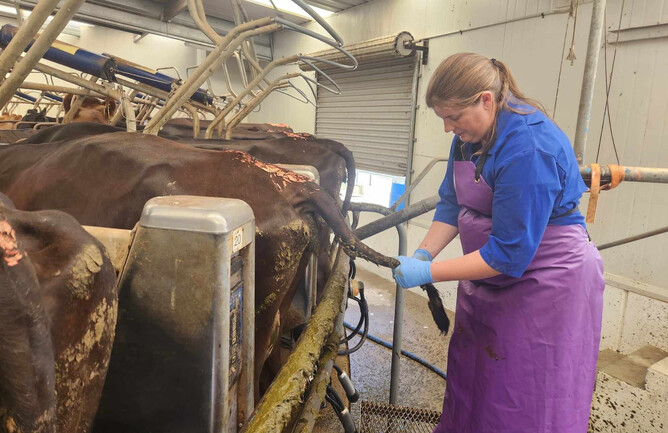The tail of a dairy cow plays an important role in communication, locomotion, and fly control, and is a very sensitive appendage, containing a large number of pain receptors.
The problem is, even though docking has been banned since 2005, damaged tails - where the damage breaks the connections between the vertebrae - are now one of the most common cattle welfare-related issues brought before New Zealand courts (R. Laven, personal communication).
There are varying degrees of damage, some of which may be caused by sheds or milking apparatus (cup removers) and some which may be caused by people.
Sometimes, the tail bones are actually broken, sometimes dislocated, or sometimes there is trauma like cuts, swelling or poo rings.
Regardless of whether tail injuries are caused by malicious intent, ignorance or something else on-farm, a damaged tail causes significant pain and distress, can lead to long term or permanent loss of function and long term or permanent pain sensitivity, with impacts on how a cow communicates with her world.
A team of researchers from EpiVets and VetNZ, with funding help from Sustainable Fibres and Futures Fund, VetEnt, WelFarm, Massey University and Dairy Cattle Veterinarians Society, has been working to find out more about this problem in NZ.
What we did
We utilised 200 randomly selected farms from veterinary practices across nine regions of NZ.
Veterinary clinics enrolled 20-25 farms each, depending on region, with one or two trained technicians scoring per region. All cows present at the milking or pregnancy testing event, at which scoring took place, were eligible to be tail scored.
The scoring was completed between February and April 2022.
From these 200 farms, 10 farms were randomly chosen from eight regions to have their R1 and R2 heifers scored as well.
The R2 heifers were scored prior to arriving on the dairy farm between May and June 2022 and the R1 heifers were scored in approximately October-November 2022, before they left the farm to grazing.
A total of 30 beef herds were randomly selected from the client base of VetEnt and VetNZ in Waikato and Southland to have scoring completed in approximately May 2022.
A modified version of the NZ Veterinary Association Industry Scoring System was used. Lesions were recorded as deviated (i.e. non-linear deformity), shortened (tail appearing shorter than normal) or trauma (all other lesions).
The location of lesions was defined by dividing the tail into three equal zones: upper, middle and lower.
A cow could have more than one lesion type and location, and/or multiple lesions of the same type, but for the prevalence calculation, only the presence or absence of a particular lesion was assessed.
Results:
Adult dairy cattle
The median prevalence of deviation was 9.5% (range 0.9-40.3%); 0.9% for trauma (range 0-10.7%) and shortening was 4.5% (range 1.3-10.8%).
The prevalence of deviation and trauma varied between region; the median prevalence of deviations ranged from 6% on the West Coast to 13% in the Waikato, and the median prevalence of all tail damage from 7% on the West Coast to 29% in Southland (see Figure 1 below).
R2 dairy cattle
A total of 7739 dairy heifers across 70 farms from eight regions had their tails scored.
The median prevalence of tail deviation across all heifers was 1% (IQR 0-2.4%), with a range from 0-15.6%.
A total of 29 out of 70 farms (41%) had no heifers with tail deviations.
From the 70 farms, 46 (66%) had no heifers with any tail shortening, with another 15 (21%) with just one heifer with a shortened tail.
The maximum percentage of a mob of heifers with shortened tails was 9.9% (7/71 heifers).
There were very few groups of heifers that had any tail trauma present, with 56/70 (80%) without tail trauma.
The prevalence of tail damage varied across regions, with the median prevalence of deviations within regions ranging from 0% on the West Coast, to 3% in Northland.
R1 dairy cattle
A total of 9471 dairy calves across 76 farms from eight regions had their tails scored.
The median prevalence of calf tail deviation between all farms was 0% (IQR 0 - 0.9%), with a range from 0-11.6%.
A total of 47 out of 76 farms (62%) had no calves with tail deviations, and there was no evidence of tail shortening on any calf on any of the farms. Meanwhile, there were only three calves in total, with one of three individual farms, with evidence of tail trauma.
The prevalence of tail damage varied across regions, with the median prevalence of deviations greater in Northland (3.8%) compared to the other seven regions.
Beef cattle
There were a total of 3130 beef cattle scored from 24 farms; 986 in Southland and 2144 in the Waikato.
The prevalence of tail damage in beef cattle was 4%, with a range from 0-39%. Beef cattle with deviations/trauma were recorded at 2%, with a range from 0-17%.
Conclusion
This study was one of the first of its kind in NZ.
While it is possible to find damaged tails in R1 and R2 heifers as well as beef animals, there is a vast difference between those groups and adult dairy cattle, suggesting the majority of damage is happening once they reach the dairy shed.
The proportion of cows identified as having damaged tails was consistent with recent reports from NZ and Ireland. However, at 11.5%, the proportion of affected cows is still not acceptable for NZ.
An industry-wide programme is needed to reduce the proportion of affected cows.



